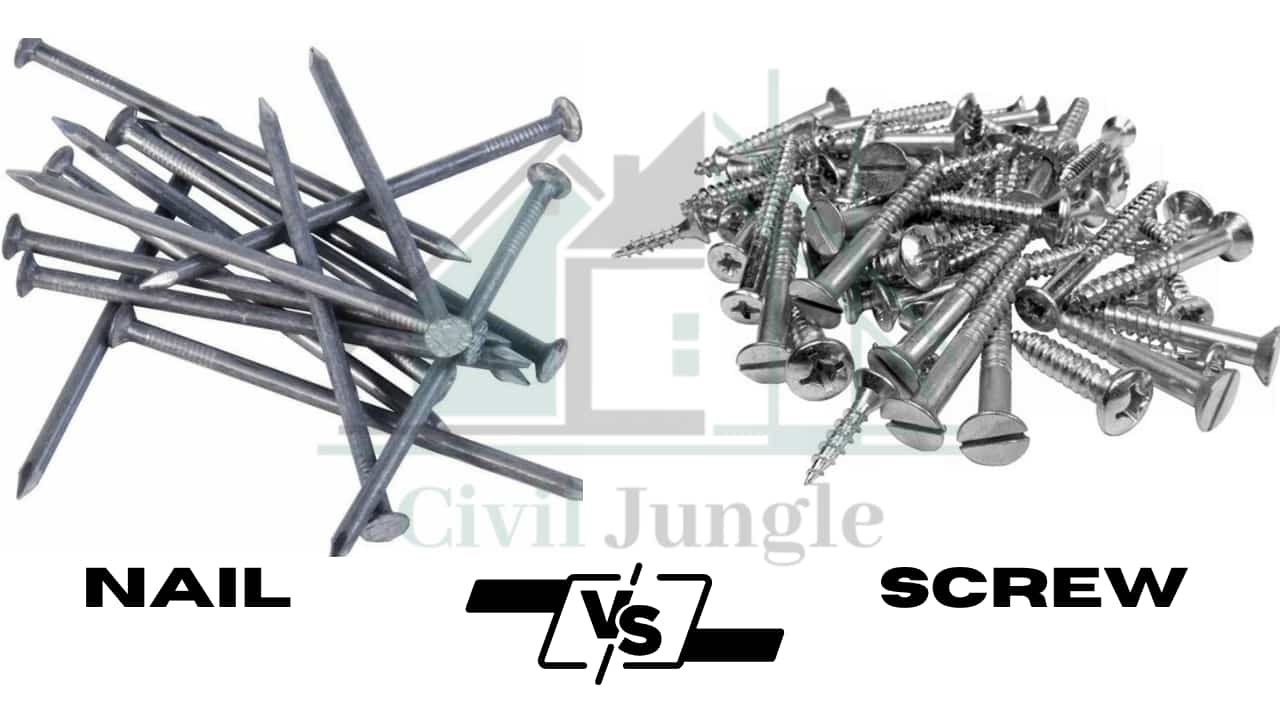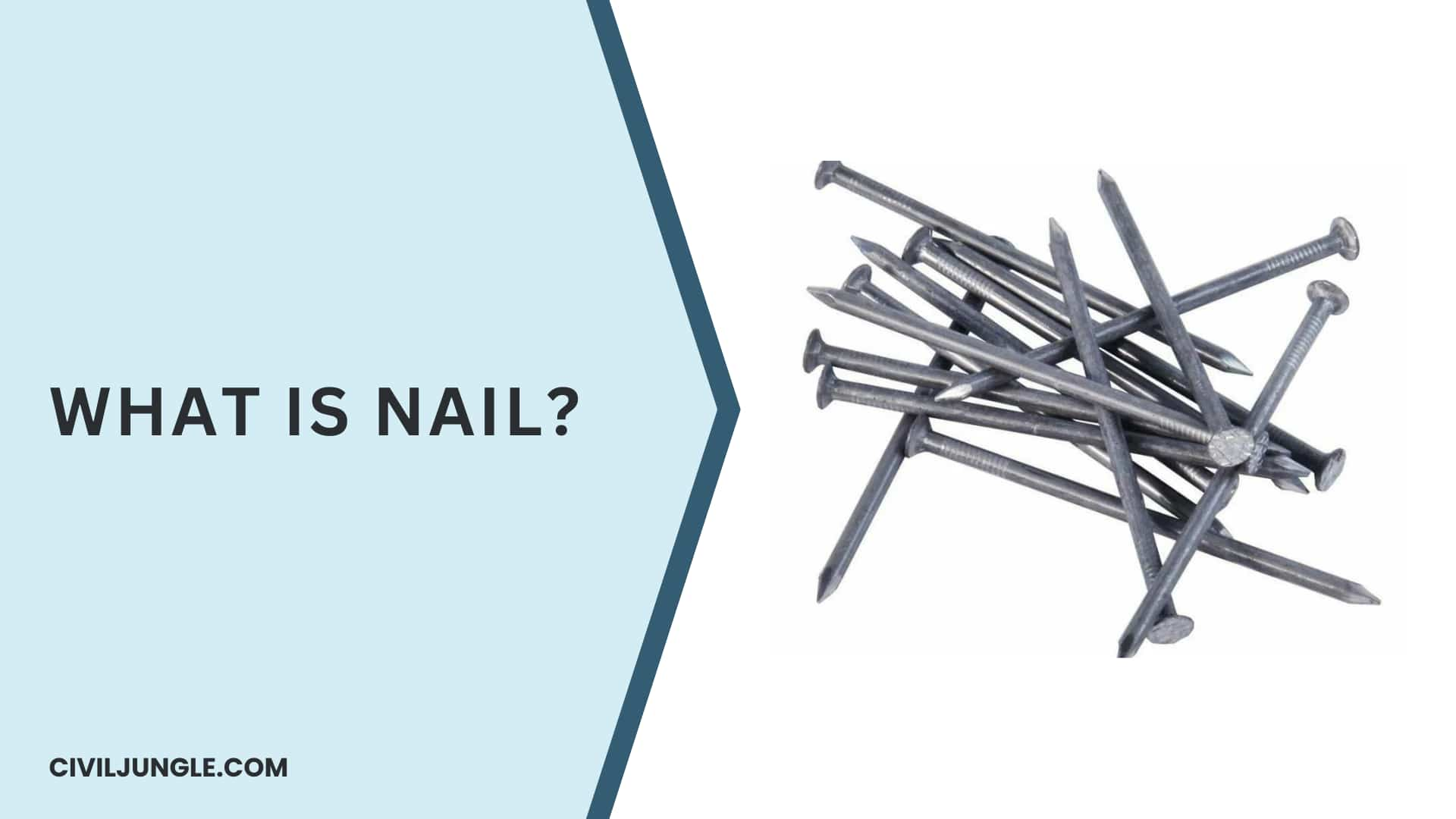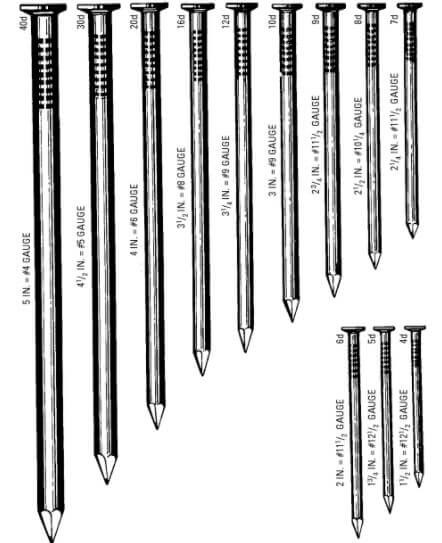What Is Nail?
Important Point
A nail screw, or simply a nail, is one of the most common fasteners used in construction. Up to the end of the Colonial period, all nail used in the United States were handmade.
They were forged on an anvil from nail rods, which were sold in bundles.
These nail rods were prepared either by rolling iron into small bars of the required thickness or by the much more common practice of cutting plate iron into strips by means of rolling shears.
Nail is available in a wide range of sizes, materials, and shapes, geared to a particular use or purpose Fastening with nail is the fastest and easiest way to connect wood members, requiring no predrilling or preparation, as they are driven into wood members with a hammer or a pneumatic gun.
Nail is most often made of mild steel but is available in a variety of other metals such as aluminium, copper, zinc, brass, or stainless steel.
While the rest of the world measures a nail’s diameter and length in millimeters. in the U.S. they are measured in a term called pennies and designated as d.
A 2d nail is one inch (25 mm) long, a 6d nail is two inches (51 mm) long, and a 10d nail is three inches (76 mm) long. The two types most often used in construction are common and finish nail.
Common nail has flat heads are used in most construction framing and are not intended to be exposed to the environment.
A galvanized nail has a protective zinc coating on them to inhibit rust and corrosion. Finish nail is not meant to be seen; they have a tiny head and are used in finish woodwork such as casework and interior detailing.
Other types of the nail screw are box nail, casing nail, brad nail, roofing nail, cut nail, and concrete nail, each shaped differently in terms of its head, shaft, and point, to suit their particular use.
Also, read: Bolt Vs Screw | What Is Bolt | What Is Screws
What Is Screw?
A screw nail, or more commonly known as a screw, may be defined as an inclined plane wrapped around a nail and characterized by a helical ridge.
In other words, it is a long metal shaft with threads circling along its length. It also has a turning where a screwdriver can be used to rotate the screw.
A screw generally has a head with a specially formed shape. The shape determines and heads size the size of the tool to be used to turn or drive the screw. Commonly used tools are wrenches and screwdrivers.
The underside part of the head is a shank that can be fully or partially threaded. A screw thread is a structure on a coned or cylindrical shape in the form of a helix.
The top of the ridge, often described in the kinematic viscosity vs dynamic context, is known as a crest and the bottom root. The distance between the crest of the one thread to the next one is known as a pitch.
Screws are tightened by rotating the tool anticlockwise or clockwise and are usually used for joining materials that don’t have existing holes in them.
The most common types of screws used in manufacturing are drywall screws, dowel screws, mirror screws, and concrete screws.
The strength of a screw relies on the width of the thread and the distance between them. However, the more numbers of the threads, the more rotations would be required to attach the screw.
Also, if the continuous distance thread is wider, more force must be exerted on the tool in the rotations.
Screws are widely used in many applications. From motorcycles to furniture, from air conditioners to kid’s remote control cars.
Difference Between Nails And Screws
| Sr.No. | Nails | Screws |
| 1 | The nail is less brittle, so they provide greater shear strength. | Screws, on the other hand, may not be as forgiving, but their threaded shafts hold better in wood and draw boards together much more tightly and they have greater tensile strength. |
| 2 | A screw and nail difference can be noted as the shank on a nail is smooth and doesn’t have threads | Screws look somewhat similar has threaded. |
| 3 | A nail has more flexibility | Screws have more tensile strength. |
| 4 | Nail is fasteners with a flat head, smooth shank and sharp point. | Screws are fasteners with a drive located in the head and threading that protrudes down the length of the shank. |
| 5 | When considering the difference between screw and nail, a nail is driven by a hammer into materials to hold them together. They can be installed faster and are cheaper than screws. In this case (and to explain the theory), we will be using a smooth shank screw as our example. | Screws (most of the time) require a pre-drilled hole and can often cut their own threads into materials they are rated for. For the sake of argument, we are going to be discussing a deck screw for this example. Deck screws are exceptionally engineered to hold two boards of wood together tightly and efficiently. |
| 6 | Shear strength is the amount of force a fastener can handle from the sides. A nail has more elasticity than a screw. This means as forces are pushed against the sides of a nail, the nail can bend slightly to accommodate these pressures. | Considering the difference between nail and screw class 5, a screw conversely has very little shear strength. Screws that are bent will almost always snap when trying to be straightened. |
| 7 | Nail is often preferred for large projects, like house framing and installing hardwood floors, because they are typically stronger and less expensive than screws. | Screws, in contrast, are favoured for small and mid-sized projects, such as woodworking and decking, because they offer more control when inserting and extracting. |
| 8 | When comparing screw vs nail, nail is often the first choice for framing, construction, and carpentry. | Screws are a favourite fastener of woodworkers because, for example, they can be used to build jigs (temporary structures that guide and keep work consistent) for smaller projects like installing hinges. |
Useful Article For You
- Frost Wall
- What Is Drywall
- Wall Paint Finishes
- Sand Concrete Walls
- Gabion Wall Cost
- What Is a Shear Wall
- Types of Partition Wall
- Alternatives to Drywall
- How to Find Wall load
- Mount TV on Brick Wall
- Disadvantages of Wall Putty
- Weep Holes in Retaining Wall
- Pros and Cons of Sealing Brick
- Bathroom Half Wall Panels
- Long Wall Short Wall Method
- Cost to Repair Drywall Ceiling Water Damage
- How to Cover Concrete Walls in Basement
Nail Vs Screw
When deciding between screws and nails, keep in mind that nails are less brittle, so they provide greater shear strength. Screws, on the other hand, may not be as forgiving, but their threaded shafts hold better in wood and draw boards together much more tightly and they have greater tensile strength.
What Is Difference Between Nail and Screw?
When exploring the nail and screw difference, while they may sometimes look similar, these standard or custom fasteners are definitely not the same. Essentially, screws offer more resistance to breaking under tension, while nails have better resistance to motion.
Nail Vs Screw
Nails are a favorite for large jobs in construction because they’re cheaper than screws and offer shear strength — or the ability to withstand shear pressure, where two surfaces slide past each other. But screws offer superior tensile strength over nails.
Why Use Nails Instead of Screws for Framing?
Increased Strength
The exterior threading results in areas of thin metal that can easily break when exposed to stress or pressure. Nails don’t have a threaded shaft, so they aren’t as brittle as screws. And in turn, they offer greater tensile strength, making them desirable for construction and carpentry applications.
Nail Vs Screw for Hanging
The answer is simple: screws are much stronger than nails. If the item you want to hang is light-weight, use a nail. If it’s heavy, use a screw. The rule of thumb is this: when in doubt, use a screw.
Are Nails or Screws Better for Wood
While screws are better fasteners when grip strength is needed and nails the best fastener for when shear strength is needed, either one will work in most situations. Even seasoned builders will use screws when a nail would have been better simply because it’s easier to remove a screw in case of a mess-up.
Can You Use Screws for Framing Walls?
Are screws or nails better for structural framing? Nails are required in most places for structural wood framing. In the US if an inspector sees screws in structural walls they will make you take them apart and rebuild them with nails. Screws have better pullout resistance but less shear resistance than nails.
Nails Vs Screws for Deck
You can install decking using nails or screws, and in most cases, screws are the better option. Nails are more likely to pop out of the deck frame, especially if they’re made from a softer material like pine. If you choose to use nails, make sure they’re galvanized nails or stainless steel.
Screw Vs Bolt
A bolt is a non-tapered fastener that uses a washer and nut to hold objects together. A screw is a tapered fastener that mates with an existing thread or creates its own thread in a material as it turns.
Nails or Screws for Shelves
For an average bookshelf, the pullout of screws is probably more important than the sheer strength of nails, but either or both will do the job. In the long run, screwing and gluing joints is the best all-around answer to the strongest attachment you can make.
Advantages of Screws Over Nails
Screws have more holding power than nails and have a high failure strength that makes them well suited for high-stress structural projects. They’re also easier to remove.
Disadvantages of Nails Over Screws
In fact, removing nails can frequently cause cosmetic damage to the item you’re removing them from. At the same time, nails are more likely than screws to pop out of place when under pressure; small nails in particular can work loose fairly easily and tend to have some trouble holding things together.
Hang Pictures Without Nails or Screws
Use Picture Hanging Strips
We recommend using specialty sticky strips which contain a pressure-sensitive adhesive that holds until you’re ready to remove it, leaving no residue or damage. Using picture hanging strips is one of the most popular ways to hang pictures without nails.
How to Hang Pictures Without Nails or Screws Without?
Double-sided tape or Command Strips
Double-sided tape is ideal for hanging light picture frames. If you’re looking to mount heavier picture frames, it might be best to go with other alternatives like command strips to make sure that your picture frames are secure.
Best Way to Hang Pictures Without Damaging Wall
The most common way to hang artwork without nails is by using Command Strips ($12.17 for 14, amazon.com). You simply plan how you want to arrange your picture, then apply one half of the hook and latch strip to the wall and the other to the frame.
Hanging Pictures Without Nails on Wallpaper
No Nail, No Fail Options
- Command Strips. This is probably the most commonly used method of hanging up frames, canvases, and any other decor without leaving a trace on the wall. …
- Command Hooks. …
- Hang Art From Your Molding. …
- Use Your Mantle. …
- Take Up Space on Bookshelves. …
- Embrace the Wall Lean. …
- Put the Art on an Easel. …
- Clip it Up.
Hanging Heavy Pictures Without Nails
To avoid using nails, you can try adhesive hanging hooks. They stick to the wall using an adhesive strip. They are very easy to install and don’t damage your walls or leave blemishes when removed.
Like this post? Share it with your friends!
Suggested Read –
- Plywood Shear Strength
- Top 20 AAC Block Company in India
- Difference Between CPM and PERT | What Is CPM & PERT
- What Is Gypsum Plaster | Advantage and Disadvantage of Gypsum Plaster
- Difference Between Veneer and Laminate | What Is Veneer | What Is Laminate
- Difference Between Compaction and Consolidation | What Is Compaction | What Is Consolidation
- BHK Full From | What Is BHK | What does 1BHK, 2BHK, 3BHK, 4 BHK, 2.5 BHK, 1 RK, 2 BHK 2T, 3 BHK 2T, 3 BHK 3T Mean
Originally posted 2023-08-19 16:25:47.





Leave a Reply